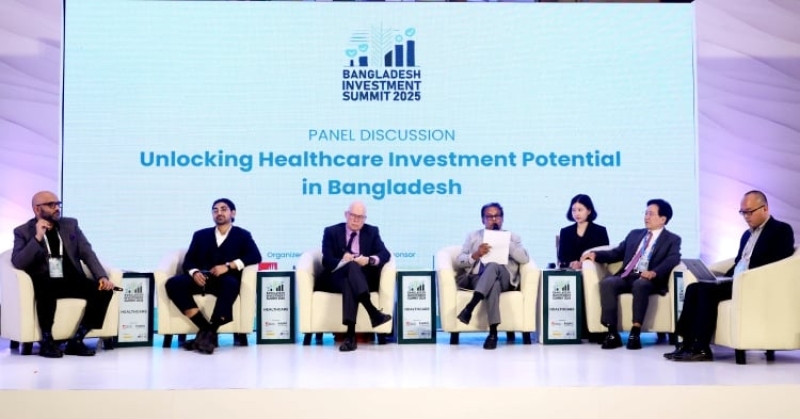- US Issues Travel Alert for Bangladesh Ahead of Election |
- Air ambulance carrying bullet-hit Hadi flies for Singapore |
- Can Dhaka’s arms recovery drive ensure peaceful polls? |
- ‘Unhealthy’ air quality recorded in Dhaka Monday morning |
- BD peacekeepers' deaths: UN chief calls Dr. Yunus, offers condolence |
Experts Urge Investment in BD’s $23B Healthcare Market by 2033

Experts at the “Bangladesh Investment Summit 2025” today called on investors to tap into Bangladesh’s rapidly growing healthcare sector, forecasting the market to reach US$23 billion by 2033. The growth is expected to be fueled by rising demand for medical consumables, advanced diagnostic tools, and digital healthcare innovations.
The call came during a session titled "Unlocking Healthcare Investment Potential in Bangladesh", held at a hotel in Dhaka. Md. Saidur Rahman, Secretary of the Health Services Division, and Sylvana Quader Sinha, Founder, Chair, and CEO of Praava Health, were the key speakers.
In his address, Saidur Rahman highlighted the sector's dynamic expansion and emphasized the vast potential for investors.
“With projections indicating the health sector’s market volume will reach $23 billion by 2033, it’s clear there is significant opportunity for both local and foreign investment,” he said.
Delivering the keynote, Sylvana Quader Sinha detailed how the medical equipment and devices market alone is projected to reach $3 billion by 2030.
“The sector’s heavy reliance on imports presents a massive opportunity for local manufacturing. From in-vitro diagnostic kits to health monitoring devices and ICU equipment — the demand is rapidly increasing,” she said.
“There is strong potential for high-return investments, especially through B2C models and manufacturing units that address the rising need for healthcare consumables.”
Sinha also outlined the broader landscape of the healthcare industry, noting that it has been growing at a CAGR of 10.3% since 2010 and currently employs nearly 300,000 people directly.
She identified five key subsectors shaping the industry:
Healthcare Facilities
Pharmaceuticals
Medical Equipment and Devices
Digital Healthcare
Medical Biotechnology
Private healthcare facilities are expanding across the country, supported by favorable policies such as tax exemptions for hospitals established outside major cities. Public-private partnerships (PPP) and government incentives are also fueling growth.
“There’s a rising demand for both primary healthcare in rural areas and specialized services in urban centers, making healthcare one of the most lucrative segments for investment,” she added.
Discussing the pharmaceutical industry, Sinha described it as a "Pharmerging Market" — projected to reach US$6 billion by 2025 with a 12% CAGR.
“Our pharma industry is self-sufficient in meeting domestic demand, especially in areas like antibiotics, gastrointestinal, and antipyretic therapies, thanks to its strong base in branded generics,” she said.
Digital innovation is also playing a pivotal role in accelerating the sector’s growth.
“Since COVID-19, digital health has emerged as a major area of innovation. The youth-driven demand for tech-enabled healthcare solutions is pushing the industry forward,” said Sinha.
The government’s Digital Healthcare Strategy 2023–2027 aims to integrate telehealth platforms, cloud-based Electronic Health Records (EHRs), and interoperable systems to improve healthcare access and reduce costs.
“This transition opens the door for investments in remote patient monitoring, cloud services, and digital platforms. Collaborations with global tech firms will be key to driving future growth,” she concluded.

